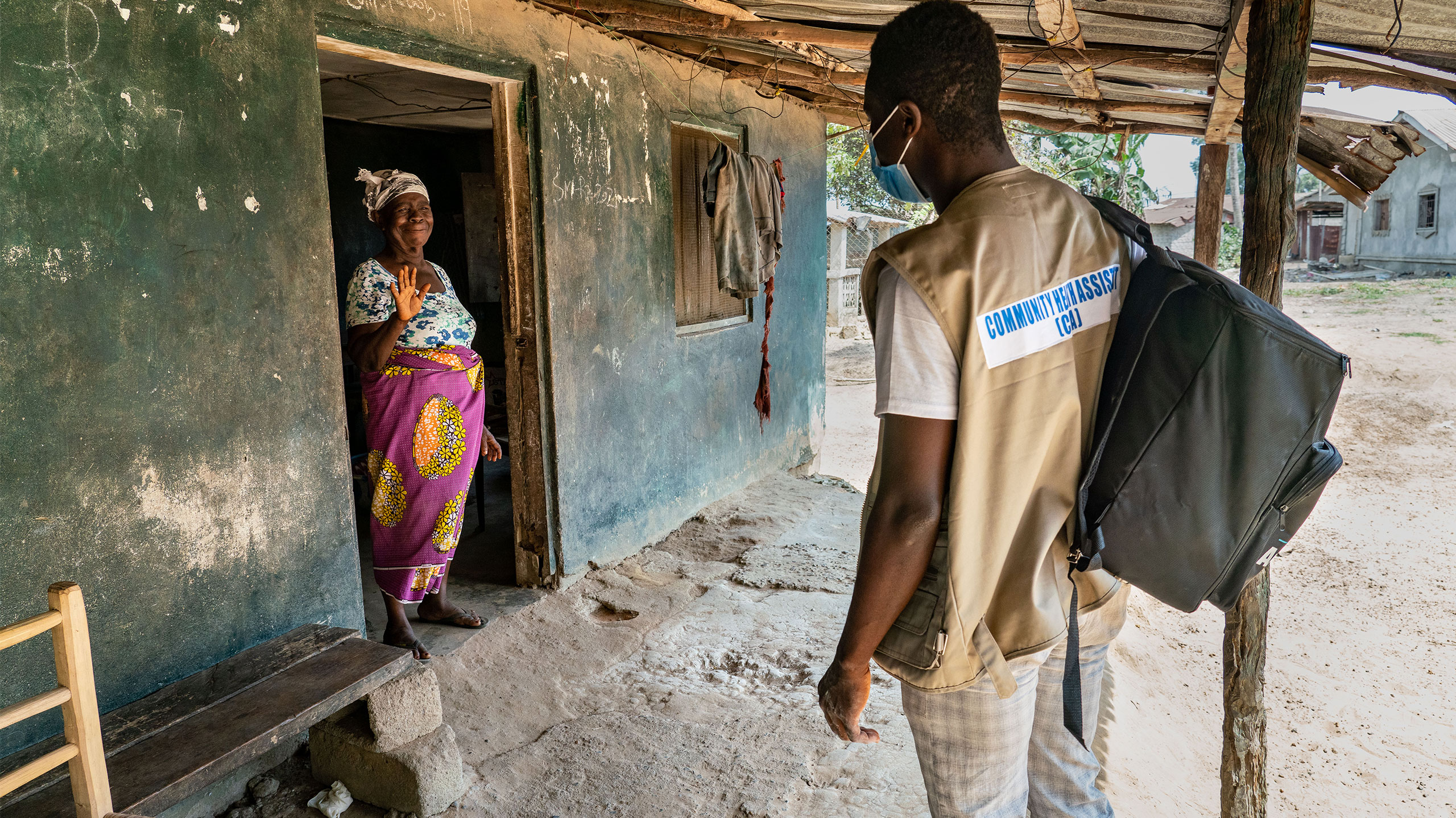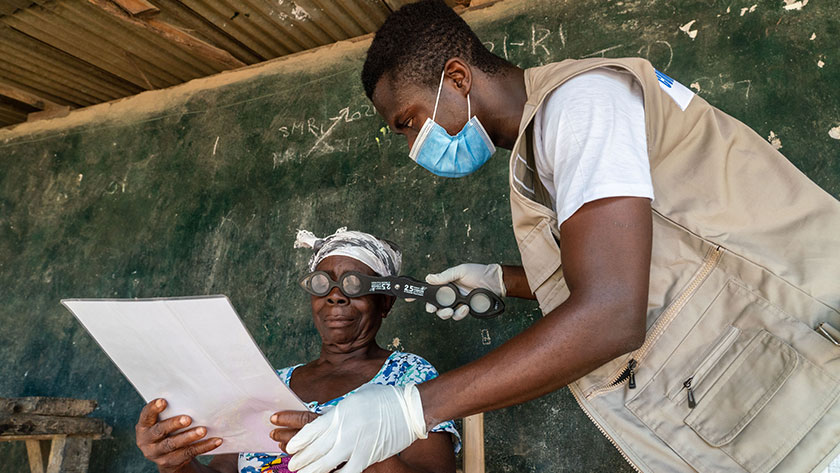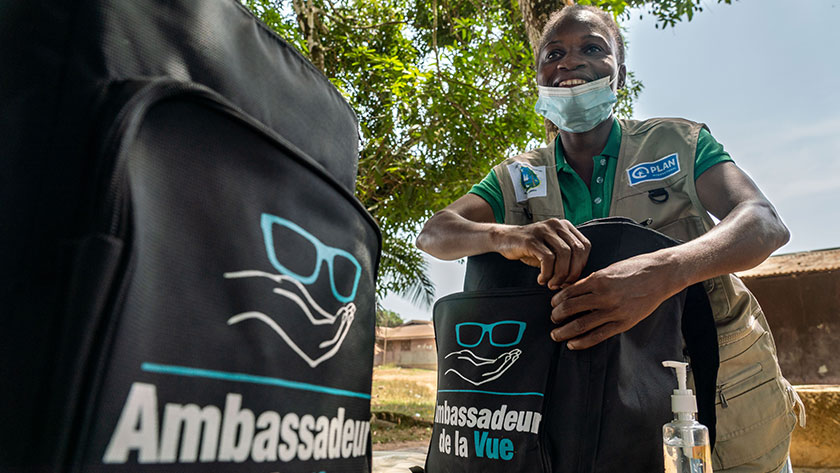Spotlight on System Orchestration: How EYElliance Works to Solve a Billion Person Problem

Imagine a life fundamentally changed by a $1 investment. For over 800 million people around the world, there’s a critical tool to sustain their livelihood that remains out of reach: a pair of non-prescription reading glasses.
It’s a simple, profound intervention far too often overlooked. For adults experiencing near vision loss in low-resource settings, eyeglasses are a powerful economic and productivity intervention—farmers can discern between their seeds for planting and garment workers can better thread needles. Research reveals that correcting near vision loss with a pair of reading glasses increases productivity by 21.7 percent, and in workers over the age of 50 that gain increases up to 31.6 percent. But across sub-Saharan Africa, and particularly in remote communities, there is very little access to this life-changing product.
EYElliance tackles this problem as a systems orchestrator—driving mutually reinforcing global and national scale strategies to eradicate this very solvable problem. In this ongoing series, we’ve looked at the various ways in which EYElliance works to change the status quo by shifting the conditions that hold this problem in place. Recognizing that promising solutions already exist, they focus on engaging and growing the ecosystem that can deploy these solutions at scale.

We explored their work with the Liberian Ministries of Health and Education integrating eye health into the national public education system and how it works to transform the inclusive optical sector—serving low and middle-income customers—into the next impact industry similar to off grid solar.
In this piece, we’ll return to Liberia where it has partnered with the Ministry of Health to incorporate eye health into the suite of services provided through its National Community Health Assistant program—the frontline Community Health Workers who provide care in rural and remote communities.
Twenty years ago, Jordan Kassalow, co-Founder of EYElliance, pioneered an approach of training Community Health Workers to perform vision screening and dispense reading glasses in remote and low-resource settings through VisionSpring and BRAC. With EYElliance’s system orchestration approach and its intent to solve the vision gap problem at scale, Liberia has proven to be an evidence laboratory—a proximate learning journey—for the hypothesis that national governments can fluidly embed this intervention into the services of frontline health workers.
“From the outset at EYElliance, one of our strategies has been to leverage this workforce—millions of government-employed community health workers around the world—and mobilize that workforce to play a role in solving this problem,” said Kassalow. “When you think about maternal and child health and child survival, and you think about malaria, and you think about these life and death kind of situations, people may say ‘reading glasses, are you kidding? Aren’t there like 50 things that are more important?’”
The Liberian Ministry of Health sees the power though of building eye health into the duties of their Community Health Assistants. “This is the most effective way for us to strengthen and sustain eye care services at the community level and to reach the most-needed with reading glasses,” said Dr. Joseph Kerkula, Program Manager, National Eye Health Program
Liberian Ministry of Health. “We have now added indicators for community eye health services into Liberia’s Community-Based Information System, which is helping us to measure the program’s impact in real time.”
For Olasford Wiah, Director of Liberia’s National Community Health Program, the life-changing potential of improved eyesight is truly transformational. “The eye is the light of the body,” he said. “Seeing your loved ones and other sceneries makes the heart rejoice.”
The Liberian government had already seen the impact of the intervention and had moved resources to invest in eye health at a national level. “It’s one of those interventions you can feel on a visceral level,” said Kassalow. “Half of adults over forty stand to increase their productivity by a third with a simple $1 investment.”

In its work supporting the Liberian Ministries of Health and Education to embed eye health into national education systems and policies, EYElliance had already cultivated relationships and gained buy-in from key ministerial stakeholders and made the case for the impact of this intervention. The Ministry of Health had been increasing its investment in eye health—including hiring a national eye health program manager—and is prioritizing building out a robust continuum of care to handle referrals for advanced treatments. “The best way to increase access to health care is to take the services to the people,” said Olasford Wiah.
Historically, much of the focus of Community Health Workers in Liberia has been on reproductive, maternal, and child health, without many services targeted at adult men, or adult women beyond their identity as mothers. The inclusion of eye health into the suite of services of the Community Health Assistant program has provided tangible benefits to all community members over the age of 40, including the traditional community and religious leadership who are often in decision-making positions of power to mobilize community resources and support Community Health Workers.
“We are working with the government to test the hypothesis that introducing services that directly benefit these groups can increase the perceived benefit of the Community Health Assistant program as a whole; and that is exactly what we are finding.” said Abigail McDaniel, Global Director for Public Sector Scale at EYElliance.
Dr. Joseph Kerkula agrees. “Community members have strongly embraced these services,” he said. “Reading glasses are helping them tremendously in effectively carrying out their routine domestic and professional duties to improve their lives and livelihoods.”
As further indication of the Ministry of Health’s confidence in its investment in this intervention, it recently decided to expand community eye health to include Community Health Promoters—a cadre of health workers who will serve urban and semi-urban communities that are within five kilometers of a health center—in addition to its workforce of Community Health Assistants who serve rural areas. It’s anticipated that with expansion the catchment area for community eye health grew from 1.2 million to 4 million people, in a country with a population of 5 million.
“I strongly believe that Community Health services should not be restricted to remote communities because there are many reasons why a person living closer to a health facility may not want to go there for a particular service,” said Olasford Wiah. “That is why we decided to go beyond the scope of the initial EYElliance pilot and empower Community Health Promoters to provide the same eye health services as Community Health Assistants.”
Liberia’s National Community Health Assistant program is considered a leading model for global health equity. Already operating at national scale, the program has deployed over 3,400 trained, resourced, and compensated Community Health Workers providing critical healthcare to 1.2 million Liberians. Through this collaboration with EYElliance, Liberia has become the first national, government-managed community health worker system where vision screenings and disbursement of eyeglasses are built into routine frontline care alongside services such as disease prevention and neonatal health.
“Eye care at the base level is so primary and simple that it’s a natural fit for these kinds of health professionals,” said Kassalow. “We had seen it work quite well in other contexts, but it was never demonstrated within a governmental community health workforce at the national level.”
EYElliance’s eye health module is now included in the national training package and someone with near vision loss can be screened and outfitted with a pair of reading glasses right out of a Community Health Worker’s backpack. With the collaboration of VillageReach and its deep expertise in optimizing medical supply chains, glasses with three levels of magnification across a variety of styles are now fully integrated into the government’s supply chain, ensuring their inclusion alongside all other commodities like antibiotics and antimalarials.
“EYElliance’s collaboration cuts across all pillars of the health system and supports the Ministry of Health to plan, integrate, implement, and sustain eye care services at the community level in line with the existing health system structure,” said Dr. Joseph Kerkula. “Establishing an enabling environment that cuts across eye health and community health has been fundamental to our success.”
Prior to the EYElliance collaboration, reading glasses were not included in the national medical supply chain at the community level. Now the Ministry of Health has strengthened capacity across the entire supply chain, from storage and distribution to data management and human resources. Identifying a point person for the National Eye Health Program at the Central Medicine Store and providing a dedicated training in the management of reading glasses for Community Health Assistants has helped to strengthen the supply chain linkages at the central level of the distribution chain, says Dr. Joseph Kerkula.
“To ensure that reading glasses reach the last mile, we have promoted total involvement of the supply chain point persons of the National Community Health Program and subnational County Health Teams,” he said. “We achieved full supply chain integration of reading glasses for Community Health Assistants through other measures such as building them into Liberia’s essential medicine list, electronic logistics management information system, and reporting forms at all levels.”
This supply chain integration is a critical difference in EYElliance’s system orchestration strategy compared to how a typical social enterprise might approach delivery of eyeglasses to the last mile, says Kassalow. “This work is complicated and slow,” he said. “Most NGOs would set up a parallel supply chain because they don’t have time to create the level of integration and increased government capacity. When the grants run out, they often go away, and they haven’t made any lasting, durable change.”

The community health worker model that VisionSpring pioneered is now a well-proven scaling mechanism to close the vision gap. As a result of EYElliance’s advocacy work and informed by its unique perspective on the ecosystem, this approach has moved from innovative outlier to firmly mainstream.
Perhaps the most important indicator of this shift is EYElliance’s engagement with the World Health Organization—among the most influential entities in scaling global health interventions. EYElliance made the case for including eye health into the WHO’s training modules for community health workers and leveraged the expertise of its network to develop the training content itself.
“Providing reading glasses at community level has already been tried and tested in various settings around the world and well documented as being an effective model,” said Emma Tebbutt, Technical Officer, Assistive Technologies Team, World Health Organization. “This gave us confidence to include them in our training modules. The added advantage was knowing that there were already training materials available that we could draw from, and Jordan was one of the key experts who gave technical input to our content development team.”
Thus far, the WHO has implemented this training module on a small scale in Tajikistan, India, Papua New Guinea, Liberia, and soon in Tanzania, says Tebbutt. Implementation in these countries has informed the development of the entire Personnel Training in Priority Assistive Products program and will be rolled out more widely during the second half of this year.
“In this WHO collaboration, we’re seeing a mainstreaming of a model that was considered very disruptive when Jordan was first pioneering it twenty years ago,” said Elizabeth Smith, EYElliance co-Founder and CEO. “Had he and I not founded EYElliance, it is likely that, over time, the model would have continued to spread and be adopted by NGOs but scale at the pace of their individual organizational growth. With EYElliance playing a systems orchestration role, the WHO has embraced the model, generating new opportunities for accelerated adoption by governments.”
The problem of the global vision gap—and the promise of improved productivity and livelihoods—is one of scalable distribution. In its work in Liberia and its collaboration with the World Health Organization, EYElliance taps into the scaling potential of national health systems to get reading glasses to the last mile.
“Dozens and dozens of governments have community health worker models, and we believe that Liberia is just the beginning,” said Kassalow. “As we prove this out in Liberia, the model has much greater replication opportunity as it spreads across many governments health systems over time.”
No Result
Notifications